Caribbean, Part VI – If it’s Monday it must be… the Dominican Republic
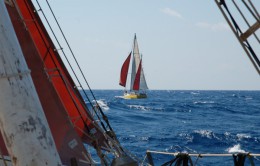
The northern winter was trickling past like sand through an hour glass. Already we were eating into the second week of April.
“June soon” says the weather rhyme; “July nigh”. But the fact of the matter is that by June the Caribbean hurricane season has often already begun. It is true that the “biggies” don’t tend to hit the place until August or September, but for a yacht at sea even a little, gale force Tropical Depression is a major nuisance; it won’t kill you or sink the boat, but it is quite likely to blow out your sails. Thus we were determined to be out of the area before the maroons went up.
In theory, when we moved on from Saba we were left with one week in which to travel north and three – just three – in which to explore the vast island which is Cuba. In practice, however… Well, in practice we just couldn’t bring ourselves to sail straight past Hispaniola without stopping.
“But only for a night or two,” we told each other.
Hispaniola is big. It’s not quite as big as Cuba but it’s bigger than either Portugal or Ireland, and it’s way bigger than all of the other, more southerly Caribbean islands put together. Even if you chuck in Puerto Rico and Jamaica, Hispaniola is still almost twice as big as the whole lot.
Given its size one is hardly amazed to discover that Hispaniola boasts a wide variety of climatic zones containing all of the usual geographical features, such as sandy beaches, high cliffs, forest-covered mountains, savannahs, swamps, waterfalls, caves (including at least one cave featuring Arawak graffiti), and lakes (including two massive saltwater lakes which come complete with crocodiles).
The island also contains two countries.
The eastern half of Hispaniola was formerly governed by the Spanish and is known as the Dominican Republic. Don’t confuse it with Dominica, which is a different place altogether. (If only Columbus hadn’t happened upon both islands on St Dominic’s day, or Easter Sunday, or whatever Domingo-day it was…)
Haiti (A History Lesson)
The western half of Hispaniola also used to belong to Spain, but in 1697 it was ceded to France and became known as Haiti. Thereafter the country’s timeline can be best described as colourful; which, in historical terms, is a euphemism for violent.
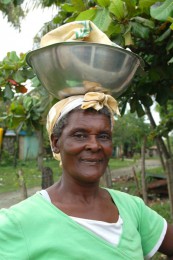
One hundred years after the French moved in and made Haiti the richest colony in the Caribbean, the slaves working on the sugar plantations rebelled. Their leader was one Toussaint L’Ouverture – and nobody with a name as wonderful as that could ever fail at anything. After a bloody struggle involving several battles, Toussaint successfully led his brethren to freedom. However, although the newly freed population merely wanted the abolition of slavery, and remained adamantly loyal to France, Napoleon was not amused. He sent his forces to kidnap and depose the black hero. Toussaint subsequently died in a French prison. This outrageous treatment of their leader only led to an increased desire, by the people, for absolute independence. They eventually got it, and thereafter – rather inevitably, one regrets to say – it was all downhill.
More recently Haiti was occupied and ruled, for a time, by America – strictly in the island’s own interests, you understand – but the intervention apparently did little to resolve the economic chaos, the corruption, and the social problems which freedom from European rule had encouraged. To this day, the majority of the population live in poverty – and not in the picturesque way, in a pretty wooden hut under a breadfruit tree. No; a large slice of the population of Haiti live in shacks made out of corrugated iron and empty oil drums, and spend their days scrounging around to find enough food to get by. When a hurricane hits Haiti, people die in their thousands, and this is not because the wind blows harder here; it’s because the houses blow away and people get hit by the flying debris.
No doubt the situation is exacerbated by greed and inefficiency, but the crux of Haiti’s problem seems to stem from the fact that it is not very fertile. I am told that if one flies over the island in a jumbo one can look down and see exactly where the border between the two neighbouring countries lies: the land to the east is green, whilst Haiti is entirely brown.
Despite the inevitable difficulties and potential dangers that it would involve, I had long harboured a desire to visit Haiti – perhaps it’s all that romantic stuff about Toussaint that attracts my interest – but after an earthquake devastated its capital city in January of this year, that idea went out of the window. The only people who have the right to visit a country which has suffered a disaster of this sort are those who can help. Gawpers only get in the way.
We were not in a position to do anything constructive – we didn’t even know what the folks there might need, four months after the event – and so we would have to give Haiti a miss. Our whistle-stop vist to Hispaniola would consist of a visit to the Dom Rep alone and – time being so very short – it would consist of a visit to just one place: Luperon.
The Dominican Republic
While Haiti was falling apart at the seams, Santo Domingo, as it was then known, was faring little better. It, too saw tyranny and revolution, and it too experienced American… ah, assistance. It even saw despotism and the massacre, by its army, of “suspected Haitian immigrants”. (Anyone who couldn’t roll the r in the word perejil (parsley) was liable to be hacked to bits with a machete.) And whilst those events were at their worst, the country almost experienced the intervention of a young man named Fidel Castro.

Even after he gained control of Cuba, the Communist leader still had one eye on his neighbours and still seems to have been of a mind to rescue them, too, from the sins of Capitalism – but Big Brother was watching closely. They weren’t going to let that kind of thing happen twice; not right on their doorstep. The Dominican Republic eventually pulled itself together and the country now has a democratically elected government answerable to the people.
This means that, so far as visiting yachtsmen are concerned, the Dom Rep is a fairly safe and secure sort of a place. When the Dominicans revolt – as they still do from time to time, I am told – the uprising takes the form of throwing refuse into the streets and burning tyres. By this means the people communicate their displeasure to their government without actually doing anyone any harm.
Luperon
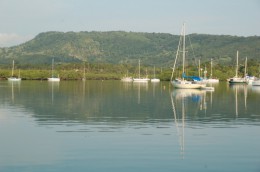
Luperon lies midway along the north of Hispaniola, towards the border with Haiti, and it is one of only seven places where a foreign yacht may clear into the Dominican Republic. According to the grapevine, the place is a den of thieves and the officials are all so corrupt that visitors end up paying over the odds. Well… we reckon we’ve been around long enough to cope with those little dramas. (Anyone who has read A Family Outing will be able to confirm this fact.) We chose to visit the place because it is said to be the best hurricane hole in the entire Caribbean, and we wanted to see whether this was really so.
Luperon was not at all as we expected it to be.
For a start, we had been told, by a friend, that the entrance is “perfectly straightforward”. So it is – but it would have been nice if the fella could have mentioned the reefs which guard either side of the little opening in the shoreline. These reefs didn’t feature on our small-scale chart. (Not so much a chart, really, as a map-of-the-world…)
Since the wind was blowing force six at the time of our arrival, and since it was blowing directly onshore, the reefs were… hum, well… quite impressive!
But having studied them from the spreaders we realised that the waves didn’t actually form a solid wall of breaking white foam twelve feet high… not quite; there was a tiny gap in the middle. And so we wove our way through this slight “dog-leg” and entered the calm sheltered waters beyond.
Calm and sheltered those waters were indeed; but not very deep. And someone had parked a jolly great barge in the middle of what we supposed (rightly, as it transpired) to be the channel. We passed on the appropriate side of a red conical buoy, shuffled around the barge (with about 12″/30cm under the keel) and – ignoring the empty expanse of water on the left – swung to starboard and came upon another, smaller red buoy.
In this part of the world they use the “Red Right Returning” system, which meant that we must leave this marker to starboard while entering the harbour. Well… it didn’t look right. The water on that side of the buoy had a distinctly muddy appearance… And it wasn’t right. Leaving the buoy hard on our starboard side – so hard that we were almost touching it – we sailed straight onto the putty.
“Furl the genny!”
In it came, slowly but surely, while Nick whizzed the handle round like a maniac.
“Drop the mizzen!”
Down it came, after a bit of a struggle – it was being pressed hard against the stays by the wind.
Then we left the buoy well to port and found plenty of water for our draught.
(By the time you get there the mark may well be back on station – so use common sense: the deeper water is in the green bit, near the middle, and not in the yellow bit. If in doubt, put out a call on VHF Ch. 68 and you will almost certainly be inundated with good advice from the folks already safely anchored within.)
Ahead of us lay a lagoon which resembled nothing so much as Salcombe Harbour in Devon, or the Helford River in Cornwall (England). It was not a bay (which is how it is generally described); it was an inlet, with many smaller arms. Like the English rias, its shores were wooded – and at first glance one could overlook the tall palms poking out of the top of the forest and ignore the fact that the trees were tropical species; our initial impression was of scrub oaks and such like.
Behind the woods lay rolling hills covered in verdant grass. The few houses on these slopes were large affairs: villas rather than huts. Meanwhile, all across the harbour were anchored yachts of all shapes and sizes, from cruising yachts as big as Mollymawk down to tiddlers which would certainly not have fared too well in the sea that we had just left.
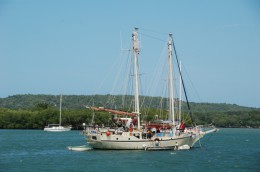
We later discovered that the majority of these fifty-odd yachts belonged to folks who have happened upon Luperon, fallen in love with the place, and bought properties ashore. Besides ourselves and Cherub (which rocked up the next morning and sailed onto the same piece of putty, on the port-hand side of that red buoy) there were only half a dozen birds of passage.
Where to anchor in all this throng? At the head of the inlet, perhaps; nearest to the quay and the village which lay beyond?
We were ambling slowly along, in the centre of the harbour, amongst the moored craft, when one of the yachts alongside us suddenly sprang to life. A family of five appeared on deck and all began yelling and waving their arms.
“What the…? Hey! It’s Free Spirit! Remember them, Nick?”
“Yes, of course I do!”
Free Spirit is a half-sister to Mollymawk. Her underwater shape is exactly the same in most respects, but above the waterline everything is completely different. When we built our boat we lopped off the proposed bowsprit, wheel-house, bulwarks, and much more besides, and we gave the boat a bermudan rig. Free Spirit, meanwhile, is the designer’s dream realised; her builder followed the plans to the letter.
We had met the boat, and met the owners, eleven years before in South Africa. But these people now waving at us were not the same family.
“I’m surprised that they recognised Mollymawk as being the same boat.”
They hadn’t; that was not what they were yelling. They were yelling, “Look out! There’s a rock just ahead of you!”
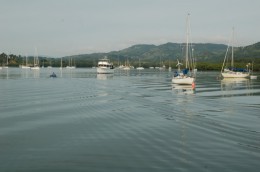
What a daft place to leave a rock! Right in the middle of the channel! Not just a rock, indeed; slap bang in the middle of the path from the entrance to the wharf there is a large shoal patch with so little water that at lowtide one can scarcely row over it. Where was God’s cruising-man when they built this part of Eden Waterworld? Taking a nap?
In other parts of the world, such as Salcombe or the Helford River, this shoal patch would be buoyed, but here, nutin’ go so. It is not marked at all, and nor are the various other shoals within the harbour. So use discretion, low revs, and polaroids; oh, and a chart, if you are fortunate enough to have one.
Clearing In
Our new friends, aboard Free Spirit, gave us a printed page outlining the charges due from visiting yachtsmen, and they told us that “the commandante” and various other authorities would probably come out to the boat when they saw our Q flag.
When they hadn’t show up by the following morning we rowed to the head of the harbour (about one mile distant) and went ashore.
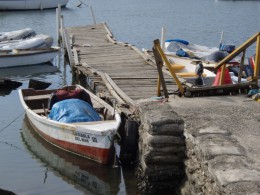
The so-called port, at the head of the harbour, consists of a small, low concrete wharf to which are moored various rotting hulks and a few rotting yachts. It’s the sort of place where boats go to die, and anyone who moors here ought to abandon all hope and realise that this will probably be the last resting place of his pride and joy.
At the inner end of the quay there is a warped and broken-down floating jetty. Or at least, it was still afloat in April 2010… By the time you arrive it may well be sitting on the bottom.
Be careful to avoid the wrecks which lie just below the water on either side of the jetty. And watch out for nails and other sharp bits of iron, sticking out from the woodwork, ready to puncture your Avon.
To clear in, one simply walks along the short causeway towards the village and, on arrival, hands over huge wads of cash.
Okay, let’s try that again:
To clear in one walks to the gate, or lifting barrier, and to the guard post. In all probability one of the chaps lounging around in front of the guard post will be the immigration officer – dressed, if your arrival coincides with a weekday, in a uniform of sorts. He will lead you into one of the porta-cabins adjacent, and after you have filled out the necessary forms he will relieve you of the following sums:
You pay $43 US for the boat, regardless of its size, and you pay $10 US each per person.
(Some people have also been asked to pay $10 US for a cat or for a dog, but this is probably a racket. Pets don’t normally need visas, and we were not asked to pay anything on behalf of Poppy-dog.)
After he has acquired this contribution to the island’s economy the immigration officer will pass you along to his neighbours for a further fleecing:
The Port Captain will demand $10 US per week, or part thereof, for the use of his harbour. (Long term residents have negotiated an annual fee.)
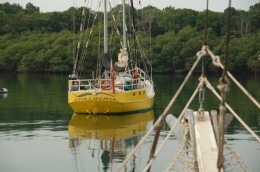
Then comes the Ministry of Agriculture. According to the information given out on various yachting websites this lot require to be paid a further $10 US per person – but we were only charged a total of $10 for our crew of four. Perhaps this was because the young woman officiating took a shine to Caesar. She insisted that he and she go together to change our money (from Euros into the local kind) at the bank!
Having visited these three people and parted with a total of $103 US we were then directed to cross a rickety little bridge, climb a small hill, and thereby gain access to the attractively sited HQ of the Coastguard (Marina Guerra).
The commandante of the Marina Guerra was an absolute classic of the third-world army captain type. He was friendly and very casual, but one could sense a brutal and dispassionate interior which would permit no messing. Since our arrival coincided with Sunday he was dressed in his muftis – a T shirt and shorts – but there was a large revolver tucked into his waistband below his beer gut.
The lads on duty by the commandante’s side wore the most remarkable outfits, consisting of boiler suits covered in a mass of pixelated blue and white blobs. It would have provided them with a very effective camouflague in a snowstorm. One of them was using his semi-automatic in the manner of a workman leaning on a shovel.
The commandante is supposed to visit all vessels arriving in Luperon – whether from abroad or from another port – but he doesn’t actually have a boat; he depends on the yotty concerned to give him a lift. When he learnt that this would involve being rowed one mile (each way) in a small, soggy dinghy he shrugged his shoulders and said, “Okay. Forget it. Welcome to the Dominican Republic.”
Other Charges
In theory one is also supposed to handover $10 US every time one brings ashore a bag of rubbish. This is to pay for it’s disposal, but since the said disposal consists of setting fire to he dustbin (which is on the quayside) we weren’t about to play that game.
Most people also pay a further $20 US to the commandante when they clear out. This charge is said by some to be a legal requirement, in payment for your despacio (or onward clearance out of the Dom Rep) but if you tell the fellow that you have just spent your last cent he shrugs his shoulders and signs the form quite happily anyway.
Illegal Charges
The avowed purpose of the gate and the guard which control access to and from the port is to prevent contrabandistas from plying through Luperon. According to the resident yotties, they do this anyway – with the full approval of the authorities (of course) – but appearances must be maintained. Likewise, the visit by the commandante is part of the same scheme of coastal defence. If the idea takes their fancy, the agriculture people and the port captain may also show up, along with M-2 (Intelligence) and the Department of Drugs. None of them showed any interest in Mollymawk, but so far as we can gather we were the only boat not to be visited at all, by anyone.
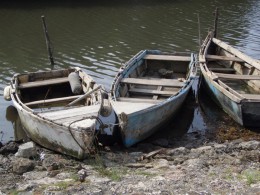
Note that there is no charge for the services – or approval – of any of these possible visitors to your boat; so don’t be tempted to hand over any “presents” which might be demanded. Just keep your cool and shake your head, apologising too, if you feel like it. It is said that bribery is a way of life in the third world – but that doesn’t mean that we have to go along with it; au contraire. Comments such as the following one make my hackles rise:
“I wasn’t asked for any fees but voluntarily tipped the men $20 each. $10 each would probably have been enough really.”
It’s people like this guy who spoil things for the rest of us.
If you move on from Luperon to another port within the Dom Rep, the authorities there will almost certainly board you – or so we were told – and they may try to impose further charges. Charges for the use of the port may be legal, but any others are not. Beware of faraudsters visiting the boat in the guise of officials. Punta Macao is reputed to be particularly bad in this respect, with yotties being obliged to bribe these “officials” around $20 to $30 US for permission to stay.
In closing, I would like to emphasise the fact that our visit to Luperon was entirely hassle free. Obviously we would have preferred not to part with over $100 US in clearance fees, but at least we knew that the charges were officially sanctioned. And after we had taken a look at the country, and witnessed the poverty, we realised that the Dominican Republic has every right to ask for contributions from (relatively) wealthy hobos enjoying their hospitality. We just hope the money went towards a good cause…
(As a matter of interest – clearing into Carriacou cost around $25 US, for the whole crew, whilst clearing into Martinique cost only 2 Euros. Clearance in Dominica cost around $20. In Antigua it cost only $14 US (but it would have cost more if we had cleared in or out in the National Park). Clearance in Nevis cost about $25 but visitors are also required to pay a daily charge for the mooring, as explained.)
Ashore
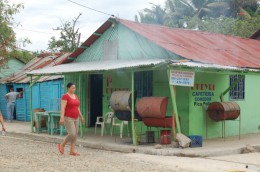
The village of Luperon lies on the opposite side of that barrier gate which guards the port. at first glance it seems to consist of a sprawling mess of small wooden and block-built houses, but in reality it is a fairly well-ordered place. The streets may be rutted and muddy, and the paintwork may be shabby, but the place actually boasts all the necessary amenities including various very small grocery shops, a small vegetable market, a bank (with a cashpoint machine which sometimes works), at least two restaurants, numerous bars, two dentists (one of whom I can personally vouch for), doctors, a hospital, and even a medical laboratory.

Internet is available at Captain Steve’s Place – a restaurant-bar situated half way along the main street. Steve hails from Florida but is married to a local girl. His bar is one of several meeting points for the local ex-pat yotties. (Others include Puerto Blanca and The Yacht Club, both of which are to be found on the harbourside to the north of the town.) Besides providing a free wifi service for his customers, Steve also has a laundry and a swimming pool. His meals are the cheapest in town, and they are good. When we told him that we didn’t eat chicken (which was the set meal of the day) he knocked up a delicious vegetable stir-fry for the same price.
Getting About
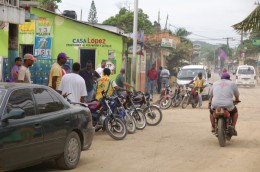
Aside from the sprawl, the first thing that strikes the new visitor to Luperon is the number of mopeds and scooters and small motorbikes which are whizzing around on the two main streets. A gathering of young men hanging out at the crossroads, beside a bar, may seem quite intimidating – until one discovers that they are not, in fact, a gang; they are the “moto-concho” chauffuers. For a few pesos they will give you a lift to any place on the island which is within half-a-day’s ride, and if your crew wants to come too, that’s no problem. Riding three up on a moped is common-place in this country, and riding two up with a gas bottle or a fridge wedged between the passanger and the driver is also permissible, or so it seems. On Sunday morning we spotted a young man and his well-dressed wife riding to church with their three small children, all on the same moped.
It comes as no surprise to learn that traffic related deaths are extremely common.
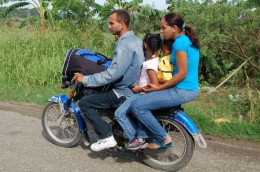
If you don’t want to risk life and limb on the back of a “moto-concho”, take a ride on a gua-gua (mini bus) or in a taxi. If you don’t want to pay the full taxi fare make sure the driver knows – and be prepared to make room for seven other people. In one car which we shared in this way the driver himself shared his seat, with a rather large lady. Hmm… P’raps it wasn’t so much safer than a moped after all.
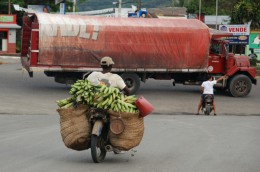
Either way, be sure, if you visit Luperon, to find some means of getting inland and taking a look at the countryside which lies behind the village. This is a marvellously lush and very beautiful place, with green rolling hills and a spectacular abundance of trees. Indeed, there were trees of all sorts, from mangoes and avocadoes and breadfruits and palms, and all the other types seen throughout the Caribbean, to trees which are good for boat-building and drum-making, trees which bear nuts or berries, trees which bear bright orange tulip-like flowers, and trees which appeared to have pink, feathery mesembryanthemums sprouting amongst their old gnarled limbs. I cannot think when I last saw such a variety of tree species.

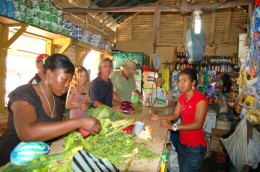
The road, throughout much of our journey, was lined with small colourful houses. We found the people everywhere to be very friendly and fairly extrovert. In temperament, if not in apparance, they are more like their Spanish ancestors than their African ones.
Shopping Trip

We were fortunate enough to have made friends with some people who owned a car, and thus we were priveledged to be given a guided tour of the countryside between Luperon and Santiago (in the centre of the island). Santiago itself was worth a visit only for the purposes of stocking the boat. It has several massive stores, including a big modern hypermarket-come-department-store (La Sirena) and a massive hardware store (of the Leroy Merlin or Homebase type). Plumbing parts, ship’s batteries and so forth were all readily available in Santiago, and the place also boasts a shopping mall with fashion boutiques. We found things to be much cheaper here than they were on any of the other islands in the Caribbean. Brown rice, milk powder, and similar staples were the same price as they would have been in Spain. Our American friends on Free Spirit reckoned that prices were much the same as back home in the states and that the cost of living was only a quarter of the cost in the Bahamas.
Hurricane Hole
Having forked out so much money for the privilege of entering the country we couldn’t bring ourselves to depart after just two days, and we ended up staying a week in Luperon. This afforded us ample time to explore the harbour and to consider its potential as a hurricane hole.
Because Hispaniola is big and relatively high (10,00ft) hurricanes coming up from the south are probably not capable of crossing the island and attacking Luperon from that side. It’s those heading for the Bahamas which present a potential problem. Every now and then one of them changes its mind and loops westward again, towards this stretch of coast. It recent years, we were told, the winds associated with these particular cyclones have never reached more than 50 knots – which is not even hurricane force, within the meaning of the act. However, the potential is obviously there. What would happen to a yacht moored in Luperon if one of those 200 knot dervishes came down upon the place?
Yi! 200 knots is a lot of wind! It’s the sort of beast which can pick up a fifty-foot boat and hurl it a hundred yards inshore. It’s the sort of wind which can uproot the palm trees and even the mangrove bushes perhaps… but assuming that the wind didn’t actually reach quite such a destructive and deadly force, a boat sheltering within Luperon would probably stand a pretty good chance of surviving.
The entrance to the harbour is sufficiently devious to prevent a big sea from entering, and the mangroves are accessible, in some places, to a boat with just over two metres draught. Yes, we reckon we would rather endure a hurricane here than in any other place that we have ever visited in the Caribbean; but, on the whole, we would prefer not to have to endure one at all – which was why we needed to be moving on.
Vamos
Besides the supposed corruption of the officials, the other thing which is supposed to spoil a stay in Luperon is the fouling. Funnily enough, during our stay here Mollymawk and Cherub both became cleaner…! – so, presumably local conditions are not conducive to the growth of ordinary slime, weed, and encrustations (or should that be en-crustacea?).
We had been told that our anchor chain, too, was likely to become covered in slimey red weed. One chap reports that after a stay of eight weeks he had “good sized barnacles on the upper part of the chain”, and we watched another yacht, which had spent a year in Luperon, spend five hours cleaning their gear as they brought it slowly aboard.
Well, I am pleased to be able to report that a one week stay does not provide the creatures with sufficient time to set up camp.
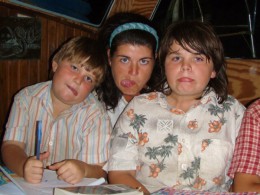
We wound in our chain, waved goodbye to the folks aboard Free Spirit, and trickled out of the harbour under full sail. Next stop Cuba – at long, long last. But would it be all that we hoped, or would we wish that we had spent longer in the happy-go-lucky land of the Dominican Republic?
